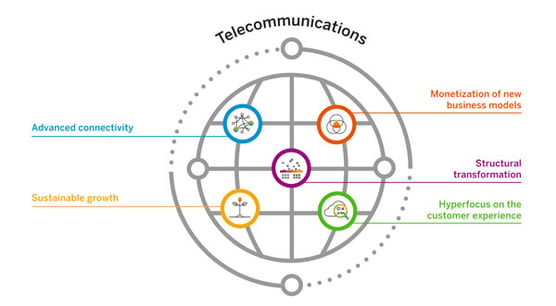As this blog series continues to explore optimizing quote-to-cash (QTC) to compliance for different industries, in this episode we dive into the special challenges faced by companies in the telecom sector and address how solutions in the SAP portfolio help overcome them.
For almost 150 years, the telecom industry has undergone massive growth, waves of change, and periodic disruptions from new technologies and evolving business models. While the headlines focus mostly on front-end, consumer-facing innovations like smartphones, video streaming, App stores, 5G networks, and ubiquitous connectivity, there is also a revolution going on within the back-end system for billing, subscriptions, order-configuration, and complex revenue compliance challenges.

Critical Factors for Success in the Telecom Back-end Systems Arena
Today's telecom services typically involve complex pricing plans, including variable rates, discounts, bundles, and add-ons. Service providers need flexible and highly scalable systems that can handle the intricate calculations and billing adjustments required to accurately invoice customers, reducing the risk of errors and disputes.
Efficient billing and invoicing processes are crucial to assure a positive customer experience. Back-end systems must be able to generate invoices promptly, address customer inquiries quickly, and handle changes to service plans or billing information without delays, leading to higher customer satisfaction.
Telecom companies often experience peak transaction levels during certain periods, such as periodic billing cycles or when launching new services. End-to-end scalability is needed to enable billing and invoicing systems to efficiently process tens of millions of transactions during these spikes without causing delays or errors.
Telcos also must comply with various regulatory requirements and standards related to billing and invoicing. Scalable and flexible back-end systems enable them to adapt to changing regulations, implement new billing standards, and maintain audit trails without disrupting operations.
From a competitive advantage perspective, telecom providers that can scale their billing, invoicing, and change order management systems effectively can respond faster to market changes, launch new services quickly, and provide more flexible billing options. This agility can give them a competitive edge in the industry by improving customer loyalty and reducing churn.
How SAP BRIM Portfolio Solutions and S/4HANA Can Help
In this section, we will unpack some of the specific applications in the SAP ecosystem that apply to these telecom industry challenges, including those in SAP Billing and Revenue Innovation Management (BRIM).
As SAP's Scott Campbell said in this recent podcast, "SAP’s Billing Revenue Innovation Management suite of solutions can help manage the back end for everything from pricing, managing orders and contracting, gathering consumption data, charging customers, billing & invoicing, commissions, collecting money and handling disputes. It’s used today by most of the largest Media and Telecom companies in the world, as well as a growing number of mid-sized telecom companies."
In working with a range of mid to large size companies in the telecom industry, the Bramasol team has seen good success at leveraging SAP solutions such as Billing & Revenue Innovation Management (BRIM) in conjunction with SAP Revenue Accounting and Reporting (RAR) to help companies gain improved visibility and management over their disparate operational processes, compliance mandates, and data repositories.
Combining pre-integrated applications from within the BRIM portfolio enables quick integration of legacy systems and helps optimize subscriber self-management of their billing, service-tier levels, and bundling of various services.
On the back-end, deploying BRIM and RAR together enables telecom companies to effectively manage complex licensing, partnering and revenue-sharing relationships to assure end-to-end visibility, scalability, data consistency, and accounting compliance.
For telecom providers, BRIM is designed to handle billing for a diverse range of services, such as voice, data, and messaging in either subscription-based or pay-per-use scenarios. The flexibility of BRIM enables telecom companies to quickly tailor offerings, optimize pricing and engage with customers to meet their specific needs.
On the front-end, the SAP Configure, Price, Quote (CPQ) application supports real-time creation of complex quotes tailored to customer needs, while also optimizing pricing within parameters that help protect margins.
Combining BRIM order-to-cash and subscription management functions with SAP Revenue Accounting and Reporting (RAR) in the back-end also enables a transparent, end-to-end process that unifies actions by all players, including the customer, sales manager, production manager, billing operations manager, and revenue manager.
To see this end-to-end process in action, watch the short video below.
To help with a smooth transition to cloud, the SAP Commerce Cloud Telco and Utilities Accelerator is an omni-channel commerce solution that is optimized for the delivery and support of telco-grade products, subscriptions, and services offerings.
 Finally, by leveraging these cross-compatible SAP solutions within the SAP S/4HANA platform, telecom companies can set the stage for a forward-looking roadmap to achieve game changing digital transformation. With new initiatives for incorporating AI throughout the SAP ecosystem and an incentivized path to the SAP public cloud, telecom companies of all sizes can rapidly take advantage of S/4HANA's expanding capabilities.
Finally, by leveraging these cross-compatible SAP solutions within the SAP S/4HANA platform, telecom companies can set the stage for a forward-looking roadmap to achieve game changing digital transformation. With new initiatives for incorporating AI throughout the SAP ecosystem and an incentivized path to the SAP public cloud, telecom companies of all sizes can rapidly take advantage of S/4HANA's expanding capabilities.
In addition, as detailed in this previous blog post, SAP's RISE and GROW initiatives are key enabling technologies for helping companies migrate to S/4HANA in the cloud.
Summary
Flexibility and scalability are crucial in the telecom industry's billing, invoicing, and change order management processes to handle growth, peak loads, complex pricing, and regulatory compliance, while assuring a positive customer experience, optimizing costs and staying competitive in a dynamic market.
As the telecom market continues to experience new waves of change in service offerings, along with the need to maximize margins and profits, companies will benefit greatly from the ability to bring all aspects of the end-to-end, quote-to-cash-to compliance process together in a single unified, and highly scalable system.
Click Here to Request More Information Regarding Your Unique QTC/RevRec Requirements
For More Information, check out these resources:
- Video: BRIM Overview
- Forecasting and Planning for the Digital Solutions Economy
- DSE and RevRec Compliance,
- DSE Data Volume, Velocity, Density and Complexity
- Embedded Analytics for DS

